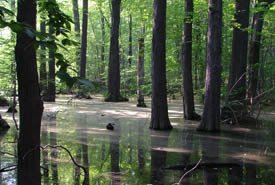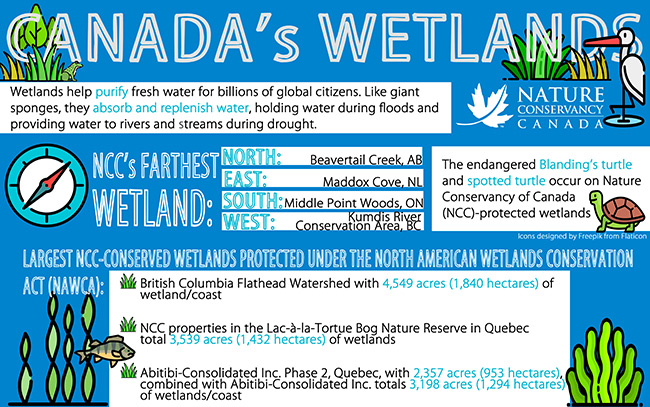All about wetlands

Forested wetlands in summer (Photo by Mary Gartshore)
Wetlands help purify fresh water for billions of global citizens. Like giant sponges, they absorb and replenish water, holding water during floods and providing water to rivers and streams during drought. Wetlands also provide vital nesting, breeding and staging grounds for waterfowl and many other species, and they are among the planet’s most diverse and productive ecosystems. And that’s barely skimming the surface of the wonders of wetlands.
In spite of their important roles, our world’s wetlands are facing serious woes.
It is estimated that 64 per cent of the world’s wetlands have disappeared since the 1900s. Canada, home to a quarter of the world’s wetlands, is not immune to this trend. Southern Ontario, for example, has lost an estimated three quarters of its wetlands to cities, farms and roads.
The Nature Conservancy of Canada (NCC) has protected wetlands across the country for the benefit of wildlife and people for over 55 years. Through the development of Natural Area Conservation Plans, we identify the places that most urgently need conservation. We then partner with private landowners, communities, governments and other organizations to conserve these important habitats — including wetlands, floodplains and shorelines.
To date, NCC has secured over 387,000 acres (156,613 hectares) of wetland and associated habitats for migratory birds and other species under the North American Wetlands Conservation Act (NAWCA).

Here are some facts about NCC-protected wetlands across Canada:
Largest wetlands protected by NCC under NAWCA
- British Columbia Flathead Watershed with 4,549 acres (1,840 hectares) of wetland/coast;
- Lac Portage with 1,530 acres (619 hectares) of wetland/coast (east of Thefford Mines, along Quebec/Maine border);
- NCC properties in the Lac-à-la-Tortue Bog Nature Reserve in Quebec have a total of 10,378 acres (4,200 hectares) of wetlands.
Where is NCC’s most northern wetland?
Beavertail Creek (sedge and shrub marsh), Alberta.
Where is NCC’s most southern wetland?
Middle Point Woods, Pelee Island (silver maple swamp), Ontario.
Where is NCC’s most eastern wetland?
Maddox Cove (treed and open bog), Newfoundland and Labrador.
Where is NCC’s most western wetland?
Kumdis River Conservation Area (estuary), British Columbia.
Most endangered wetland species on an NCC property
Blanding’s turtle and spotted turtle (listed as endangered by the International Union for Conservation of Nature) occur on NCC-protected wetlands in Ontario and Quebec.


